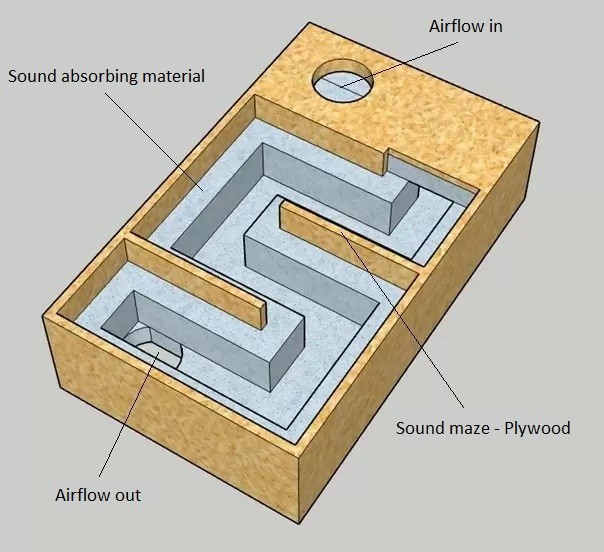How to make a sound maze for silent ventilation
In order to supply and discharge air in a room or sound studio, you need two things: a ventilation unit, such as the Aeropac, that supplies air and a sound maze for the removal of air. On this tips page we explain you how to make a sound maze by yourself that can be applied in your home studio.
Why use a sound maze?
In order to optimally ventilate, a so-called 'draft' effect is required, this means that about the same amount of air has to be supplied as is being discharged. For this to happen as quietly as possible, and with as little sound leaks as possible, you need a sound maze. A sound maze can be applied to the supply or exhaust of air, depending on the situation. You can see a sound maze as a damper, it filters sound out the air.
What you need to make a sound maze
To make a sound maze (see sketch) you need a sheet of plywood or a thick MDF panel. With this material you make the walls and the partitions of the sound maze. Furthermore, you need an sound absorber, we recommend using Akotherm D40. Akotherm is fire-resistant, moisture-resistant and has higher absorption values than foam. As for the assembly of Akotherm, you use Stauf Extreme Tack.
Do you have a sound studio or other rooms where a lot of sound is produced? First, equip the sound maze on the inside with Isomat TS 14. The high mass of the Isomat ensures that the insulation value of the sound maze becomes optimal. Then apply the Akotherm sound absorption to the Isomat. You do not have to equip the baffles with Isomat, but with absorption material. For a beautiful finishing of the holes through which the air is supplied or removed, you can use a ventilation grid.
Points of attention
When you need to make a hole through a cavity wall, you should apply a conduit. Cavity walls are regularly home to vermin and stale air. If you want to use the sound maze outside, use a waterproof sheet material for the construction and seal the seams and cracks from the inside and from the outside. Supply and discharge channels leading outside should not be completely verticle (viewed from the inside of your space) to prevent rain from penetrating.
Questions? 
Do you have any questions about this topic? Please feel free to contact us.

 Sound Insulation
Sound Insulation  Soundproofing
Soundproofing  Vibration Isolation
Vibration Isolation  Silent Ventilation
Silent Ventilation  Accessories
Accessories  Thermal & Acoustic Insulation
Thermal & Acoustic Insulation